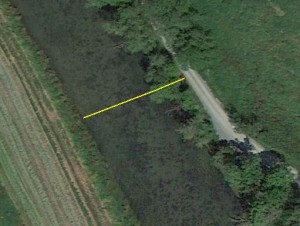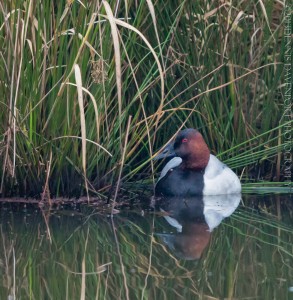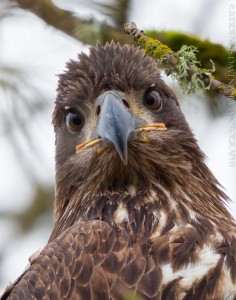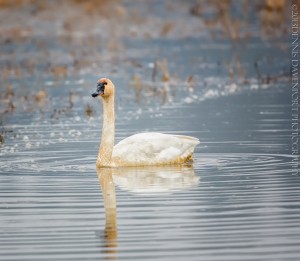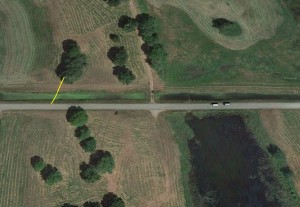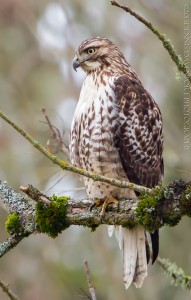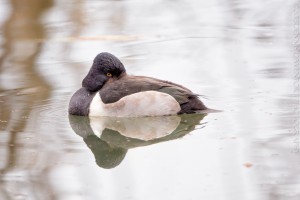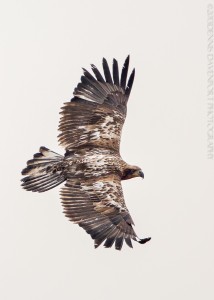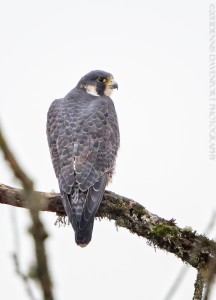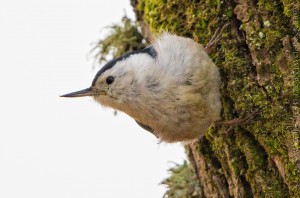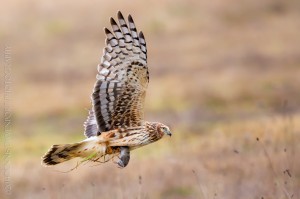Hi, all! Returning now with my last wildlife photo shoot of 2013, Dec. 30. It was a gray and pretty dark day so I saw some fairly high ISO settings which meant some extra unwanted noise in some shots. But I can’t blame it all on the high ISO—the person (me) behind the camera needs to remember to not underexpose shots especially at high ISO’s. Increasing exposure during post processing, even a little, adds unwanted noise that destroys detail. Getting a sharp, well lit image in the camera results in having to add only a touch of sharpening and little to no noise reduction to progress to the final image in post processing. Let’s move on to the images for the day.
At marker #11, the tree this Bald Eagle is in is 275 feet from the road–a common perch for many eagles at the refuge. Here’s the Google Earth aerial image of the actual location of the shot and then the image itself. The yellow line in the aerial image is the camera’s line of sight.
Checking out the skies. Canon 5D Mark III, 1/320, f4, ISO 2000, 500mm. (8:10 a.m.) [Click on each thumbnail for a larger view of the photos!].
This next image is of a Canvasback, a duck not seen often at this refuge–especially at this relative close distance of 100 feet. The bird was all the way across the water and seemed to be wary of me and quite timid. It wasn’t long before he ducked (no pun intended) behind the grasses to his right. This is one of the images where I used medium high ISO and also underexposed it in camera. The relative darkness of the morning also didn’t provide good contrast on the eye to achieve good focus using AF. If I had it to do over again, I might try focusing on the bird’s breast where black and white meet at a point that is close to the same vertical plane as the bird’s eye. This might have improved focus. Regardless, it’s a cool duck and I’m glad I got a shot. Right below the image is a video of my encounter with this duck. (Looking into the future, it turns out this duck stayed around for quite a few weeks and I believe I got some better shots of it in later weeks, which I’ll be posting soon).
Here’s the aerial image depicting the location of the shot from the road, across the water.
Canon 5D Mark III, 1/200, f4, ISO 2000, 500mm. (8:24 a.m.)
Oh, and one other tip for those of you who use a long lens from your car with a bean bag for support…it’s best to refrain from laying the barrel of the lens– especially the point on the lens where the manual focus ring is– on the bean bag. After you’ve focused using AF, then you recompose for the shot, that little movement can easily turn the manual focus ring enough to destroy the work your AF just accomplished, and leave you with a trash can filler. I position my tripod mount so that the mount is under the lens and acts as a foot to rest on the bean bag. Many times I’ll rest both the mount and the camera on the bean bag for even more stability. So be aware of the location of your manual focus ring and never let it touch the bean bag (or the window frame of your car) while shooting.
A kind of boring video of the Canvasback watching a parade of coots swimming by. Maybe he got bored when the parade stopped and then hid behind the grass. Be sure to select 1080p resolution and full screen for the best quality.
A Bald Eagle has something under its feet but I never could see what. I put on the 2x for this and I recall the bird being about 100 feet off the road. The next two shots are of the same bird.
Canon 5D Mark III, 1/400, f8, ISO 2500, 1000mm. (9:42 a.m.)
Canon 5D Mark III, 1/500, f8, ISO 2500, 1000mm. (9:42 a.m.)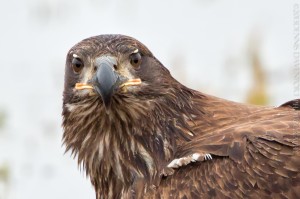
This first year eagle was up in a tree about 35 feet away. Canon 5D Mark III, 1/640, f8, ISO 2500, 1000mm. (10:32 a.m.)
A Tundra Swan was hanging out by its lonesome for awhile but it wasn’t long before it paddled its way toward the flock and much further from the road. Canon 5D Mark III, 1/1250, f5.6, ISO 1250, 700mm. (11:15 a.m.)
Between markers #2 & 3, on the right, I spotted this lovely Red-tailed Hawk perched fairly low at just under 100 feet. First the aerial then the bird image.
Canon 5D Mark III, 1/400, f5.6, ISO 1250, 700mm. (11:32 a.m.)
A Ring-necked Duck is trying to catch some zzzzzz’s but has one eye on me.
Canon 5D Mark III, 1/400, f5.6, ISO 1600, 700mm. (11:32 a.m.)
Talk about having its eye on me, this Hooded Merganser is giving me the ‘evil’ eye!
Canon 5D Mark III, 1/320, f5.6, ISO 1600, 700mm. (12:36 p.m.)
And his girl friend. Canon 5D Mark III, 1/320, f5.6, ISO 1600, 700mm. (12:37 p.m.)
A 3-year old Bald Eagle gives me a fly-by tilting the wings just right.
Canon 5D Mark III, 1/1250, f5.6, ISO 1600, 700mm. (12:41 p.m.)
After it made its turn.
A Peregrine Falcon perches with his back to me at about 140 feet. An awesome bird!
Canon 5D Mark III, 1/1000, f5.6, ISO 2000, 700mm. (12:46 p.m.)
Our 3-year old again, I believe in the same tree as the Peregrine. The eagle makes a higher quality picture because it takes up more pixels than the falcon.
Canon 5D Mark III, 1/1000, f5.6, ISO 2000, 700mm. (12:52 p.m.)
While I was shooting the eagle and the falcon, this White-breasted Nuthatch was walking around on a tree trunk.
Canon 5D Mark III, 1/1000, f5.6, ISO 2000, 700mm.. (12:52 p.m.)
“And that’s all there is,” in the words of Walter Cronkite, for this day, Dec. 30, 2013. My next photo shoot was Jan. 6, 2014, and I’ll be working on that next. Here’s a preview of one of the shots from Jan. 6.
See you next time! Until then, take care all.


